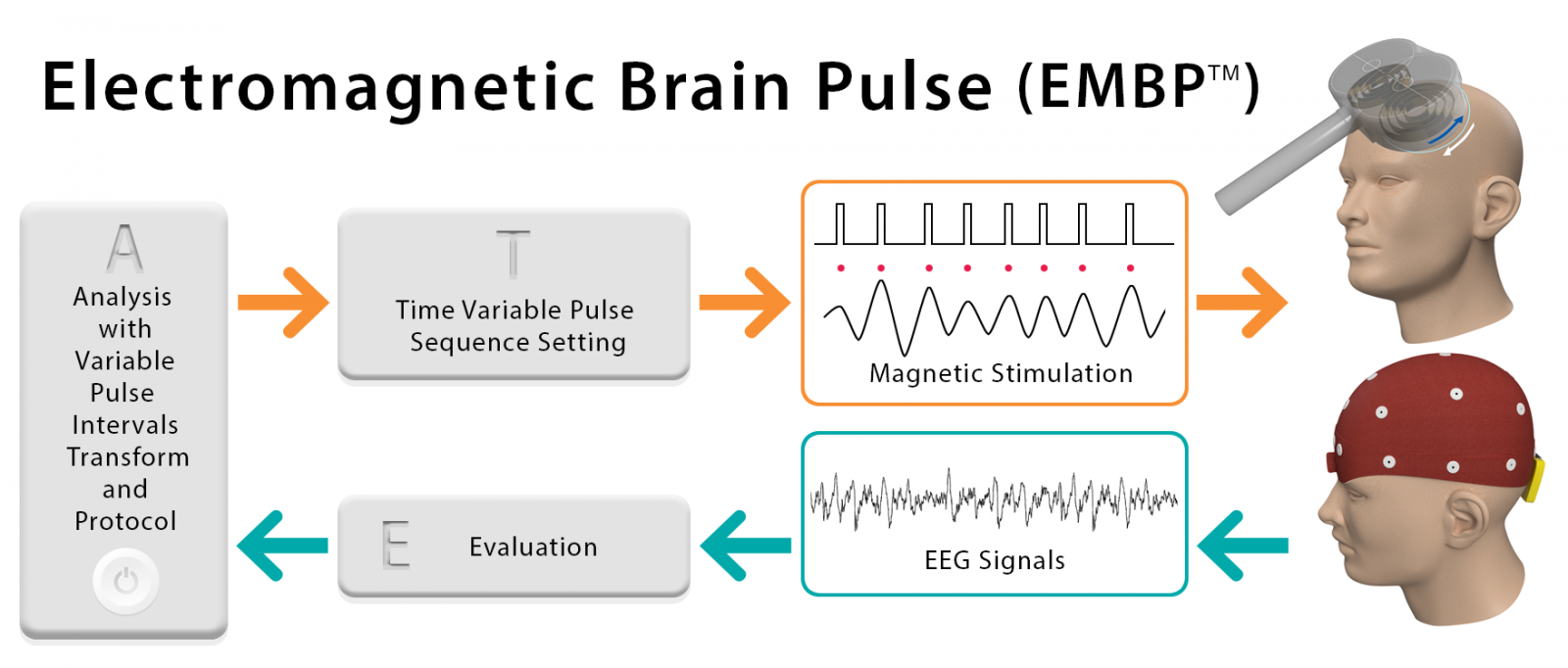ABOUT EMBP
 |
EMBP™ |
Electromagnetic Brain Pulsing (EMBP™) is a personalized, non-pharmaceutical, and non-invasive neuromodulation treatment that alters nerve activity through the targeted delivery of stimulus to specific neurological sites in the body in order to help restore and optimize brain functionality.
EMBP™ Treatment uses a suite of Class II medical devices, including electroencephalogram (EEG) and transcranial magnetic stimulation (TMS) to uniquely image electric activities in the brain, identify areas in the brain that may not be functioning properly. An EEG is conducted on a patient experiencing physiological and/or medical conditions in need of treatment. The raw EEG data is analyzed with a Variable Pulse Intervals transform algorithm resulting in a unique patient EEG Variable Pulse Intervals signal. The pattern of the EEG signal is used to program the transistor-transistor logic (TTL) pulses, or other triggers, generated by the transcranial magnetic stimulation (TMS) medical device into Variable Pulse Intervals. TMS is administered to the patient with Variable Pulse Intervals for a time sufficient to modulate brain activity which results in an improvement of the physiological or clinical condition being treated.
The development of EMBP™ technology is based on our prior research of the brain's physiological nature in electrical oscillation, energy metabolism, and their relationships with cognitive functions and mental disorders. Photic driving and TMS studies are demonstrations that the brain's electrical activities follow the physics law of symmetry and conservation. External repetitive stimulation near or away from the brain's intrinsic pulse interval variation can effectively modulate its activities by enhancement or perturbation. In recent years, studies have shown that TMS, targeted by using an evaluation of an individual's EEG, can effectively treat neuropsychiatric disorders including major depressive disorders, anxiety and SUD and addiction.
In the past 15 years, a growing body of literature following this theory has been published, dozens of patents have been granted, and the principles within the theory have been adopted by many other research groups, manufacturers and clinics.

 |
EMBP™ |
Electromagnetic Brain Pulsing (EMBP™) is a personalized, non-pharmaceutical, and non-invasive neuromodulation treatment that alters nerve activity through the targeted delivery of stimulus to specific neurological sites in the body in order to help restore and optimize brain functionality.
EMBP™ Treatment uses a suite of Class II medical devices, including electroencephalogram (EEG) and transcranial magnetic stimulation (TMS) to uniquely image electric activities in the brain, identify areas in the brain that may not be functioning properly. An EEG is conducted on a patient experiencing physiological and/or medical conditions in need of treatment. The raw EEG data is analyzed with a Variable Pulse Intervals transform algorithm resulting in a unique patient EEG Variable Pulse Intervals signal. The pattern of the EEG signal is used to program the transistor-transistor logic (TTL) pulses, or other triggers, generated by the transcranial magnetic stimulation (TMS) medical device into Variable Pulse Intervals. TMS is administered to the patient with Variable Pulse Intervals for a time sufficient to modulate brain activity which results in an improvement of the physiological or clinical condition being treated.
The development of EMBP™ technology is based on our prior research of the brain's physiological nature in electrical oscillation, energy metabolism, and their relationships with cognitive functions and mental disorders. Photic driving and TMS studies are demonstrations that the brain's electrical activities follow the physics law of symmetry and conservation. External repetitive stimulation near or away from the brain's intrinsic pulse interval variation can effectively modulate its activities by enhancement or perturbation. In recent years, studies have shown that TMS, targeted by using an evaluation of an individual's EEG, can effectively treat neuropsychiatric disorders including major depressive disorders, anxiety and SUD and addiction.
In the past 15 years, a growing body of literature following this theory has been published, dozens of patents have been granted, and the principles within the theory have been adopted by many other research groups, manufacturers and clinics.

